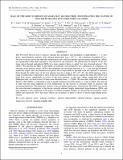HALF OF THE MOST LUMINOUS QUASARS MAY BE OBSCURED: INVESTIGATING THE NATURE OF WISE-SELECTED HOT DUST-OBSCURED GALAXIES
Author(s)
Assef, R. J.; Eisenhardt, P. R. M.; Stern, D.; Tsai, C.-W.; Wu, J.; Wylezalek, D.; Blain, A. W.; Bridge, C. R.; Donoso, E.; Griffith, R. L.; Jarrett, T. H.; Gonzales, Alexandria; ... Show more Show less
DownloadAssef-2015-HALF OF THE MOST LUM.pdf (844.8Kb)
PUBLISHER_POLICY
Publisher Policy
Article is made available in accordance with the publisher's policy and may be subject to US copyright law. Please refer to the publisher's site for terms of use.
Terms of use
Metadata
Show full item recordAbstract
The Wide-field Infrared Survey Explorer mission has unveiled a rare population of high-redshift (z = 1–4.6), dusty, hyper-luminous galaxies, with infrared luminosities L[subscript IR] > 10[superscript 13] L[subscript ⊙], and sometimes exceeding 10[superscript 14] L[subscript ⊙]. Previous work has shown that their dust temperatures and overall far-infrared spectral energy distributions (SEDs) are significantly hotter than expected to be powered by star formation. We present here an analysis of the rest-frame optical through mid-infrared SEDs for a large sample of these so-called "hot, dust-obscured galaxies" (Hot DOGs). We find that the SEDs of Hot DOGs are generally well modeled by the combination of a luminous, yet obscured active galactic nuclei (AGNs) that dominates the rest-frame emission at λ > 1 µm and the bolometric luminosity output, and a less luminous host galaxy that is responsible for the bulk of the rest optical/UV emission. Even though the stellar mass of the host galaxies may be as large as 10[superscript 11]–10[superscript 12] M[subscript ⊙], the AGN emission, with a range of luminosities comparable to those of the most luminous QSOs known, require that either Hot DOGs have black hole masses significantly in excess of the local relations, or that they radiate significantly above the Eddington limit, at a level at least 10 times more efficiently than z ~ 2 QSOs. We show that, while rare, the number density of Hot DOGs is comparable to that of equally luminous but unobscured (i.e., Type 1) QSOs. This may be at odds with the trend suggested at lower luminosities for the fraction of obscured AGNs to decrease with increasing luminosity. That trend may, instead, reverse at higher luminosities. Alternatively, Hot DOGs may not be the torus-obscured counterparts of the known optically selected, largely unobscured, hyper-luminous QSOs, and may represent a new component of the galaxy evolution paradigm. Finally, we discuss the environments of Hot DOGs and statistically show that these objects are in regions as dense as those of known high-redshift proto-clusters.
Date issued
2015-04Department
Massachusetts Institute of Technology. Department of Earth, Atmospheric, and Planetary SciencesJournal
The Astrophysical Journal
Publisher
IOP Publishing
Citation
Assef, R. J., P. R. M. Eisenhardt, D. Stern, C.-W. Tsai, J. Wu, D. Wylezalek, A. W. Blain, et al. “HALF OF THE MOST LUMINOUS QUASARS MAY BE OBSCURED: INVESTIGATING THE NATURE OF WISE-SELECTED HOT DUST-OBSCURED GALAXIES.” The Astrophysical Journal 804, no. 1 (April 27, 2015): 27. © 2015 The American Astronomical Society
Version: Final published version
ISSN
1538-4357
0004-637X